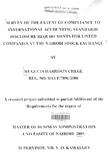| dc.contributor.author | Mugucia, Harrison C | |
| dc.date.accessioned | 2013-05-15T08:00:31Z | |
| dc.date.available | 2013-05-15T08:00:31Z | |
| dc.date.issued | 2005 | |
| dc.identifier.citation | MBA | en |
| dc.identifier.uri | http://erepository.uonbi.ac.ke:8080/xmlui/handle/123456789/22963 | |
| dc.description | Master of Business Administration (MBA) | en |
| dc.description.abstract | In 1998 the council of Institute of Certified Public Accountants of Kenya (lCP AK)
adopted international accounting standards for financial reporting in Kenya and required
companies to prepare their financial statements in accordance with IAS and the financial
statements to be audited in accordance with international standards on auditing. Since
1999, auditors opinion in the financial statement states that the financial statements are
prepared in accordance with the IAS. One may however ask whether in reality the
financial statements fully comply with the requirements of IAS.
This study attempted to answer some key questions on the extent of compliance to IAS
requirements on disclosure by listed companies in Kenya. The specific objectives of the
study were;
a) To determine the extent of compliance to IAS disclosure requirements among
companies in Kenya.
b) To identify set of factors that may have an impact on the level of compliance to
IAS disclosure requirements in Kenya.
This study looked at the 47 companies quoted at the Nairobi Stock Exchange whose
financial statements for year ending any month of 2004 had already been filed with the
NSE. The study used the disclosure index method and a percentage calculated as the total
number of items disclosed divided by the total number-.of items that should have been disclosed. A data collection instrument was compiled by bringing together the disclosure
requirements of seventeen IAS. To test whether various factors had an impact on levels
of disclosure, the study divided the population into various groupings and using t test of
significance at 5% level of confidence tested whether the means between various groups
were significantly different.
The conclusion of the study is that the overall level of compliance among quoted
companies at the Nairobi Stock Exchange was 71.95% with the highest level being
81.72% by a big company and the lowest being 55.56% by a small company. This results are disappointing in the sense that one would expect higher levels of compliance among
quoted companies and especially so as most of them are audited by the big 4 auditing
firms. Its apparent therefore that level of compliance is low in Kenya as one would expect
much lower compliance among smaller companies and especially those audited by the
very small firms.
The t-score analysis results showed that the firm size as measured by its annual turnover
and the type of the auditor as factors that have significant impact on the levels of
compliance to IAS disclosure requirements in Kenya.
Though companies in the finance sector were found to comply more than companies in
other sectors, the difference in the means for various industry categories were found not
to be statistically significant thus the industry does not have a significant impact on the
level of compliance. More profitability companies were found to comply more than those
less profitable as is the case with less geared companies. T test analysis however showed
the difference between the means not to be significant thus the conclusion that
profitability and gearing are factors that do not have significant impact on the levels of
compliance to IAS disclosure requirements in Kenya.
The findings of this study confirms the findings of previous other studies such as Kinya
(1993), Street and Gray (2001) and Elsalam and Weetman (2002) who all found that the
type of the auditor has a significant impact on the levels of compliance to IAS disclosure
requirements. The study also confirms the findings of Street and Gray in as far as
profitability and the industry as factors that do not have significant impact on levels of
compliance. The findings of this study are however different from those of Kinya (1993)
and Street and dray (2001), who found company size as not having a significant impact
on the levels of compliance. This study found company size as measured by annual
turnover to have a significant impact on the levels of compliance to IAS disclosure
requirements in Kenya. | en |
| dc.language.iso | en | en |
| dc.publisher | University of Nairobi | en |
| dc.title | Survey of the extent of compliance to international accounting standards disclosure requirements for listed companies at the Nairobi Stock Exchange | en |
| dc.type | Thesis | en |
| local.publisher | School of Business, University of Nairobi | en |

